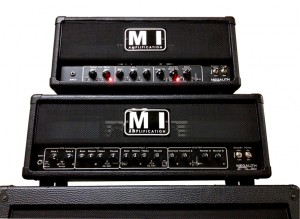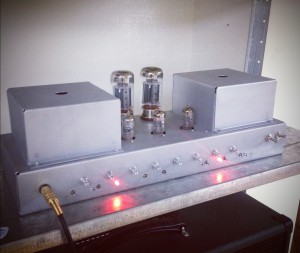MI Audio
Category Archive: Megalith Gamma
MEGALITH GAMMA AMPLIFIER – PRODUCTION PROTOTYPE
 This is the production prototype of the Megalith Gamma, shown sitting above its big brother, the Megalith Beta. The production prototype uses the final PCB layout, silkscreened powdercoated chassis, and all of the parts that would be used in the final production model. It allows us to finalise any last details before starting a large production run. We whipped up a headshell and covered it in camouflage "camo" tolex for a bit of fun. The production model will be in black. It wouldn't be metal if it wasn't in black!
This is the production prototype of the Megalith Gamma, shown sitting above its big brother, the Megalith Beta. The production prototype uses the final PCB layout, silkscreened powdercoated chassis, and all of the parts that would be used in the final production model. It allows us to finalise any last details before starting a large production run. We whipped up a headshell and covered it in camouflage "camo" tolex for a bit of fun. The production model will be in black. It wouldn't be metal if it wasn't in black!
We are really happy with the final prototype and are looking to begin production come mid-year. Below is a quick demo and explanation of some of the features of the Gamma.
MEGALITH GAMMA HIGH GAIN AMPLIFIER

Here's a sneak peek at our new Megalith amplifier, the Megalith Gamma.
The picture above is of our final prototype. We've been working on this design on and off for about two years now. There have been a few variations of the design, but in the end we went for a design which exhibited maximum simplicity, but all the tone of its big brother, the Megalith Beta.
The Gamma is an 80W (conservative) 2*6550 based amp, but can also use KT88's KT90's, KT100's, KT120's. The amp can also run El34's, 6CA7's and KT77's but the bias needs to be run a bit cooler, as the plates run at close to 700V. The screens, which are the usual culprit for valve failures, run at a conservative 400V, which hopefully translates into less tube failures. However, I question the ability of current production EL34s, 6CA7s and KT77s to handle these plate voltages (even though they're meant to).
The controls from left to right are clean and overdrive gain, 3 band shared EQ, clean volume, gain volume and contour (yes,... and MI Amp with only 8 knobs!!!). The switches are clean and overdrive bright switches, clean and overdrive EQ shift switches, channel select, overdrive gain mode (low/mid/high), and FX loop on/off. The amplifier will come with a two button foot-switch to switch channels and to switch on/off the FX loop. The two large switches are power and 3 position standby (40W low power, off and 80W high power)
The picture above gives you an insight into the way we prototype. We get a bare chassis made to spec. This allows us to mod and drill of required, but also allows us to test how the mechanical fit will work. We don't use any 3D CAD software, so sometimes we run into issues translating a 2D assembly plan into the real deal.
First thing to note about the Megalith is that it's a high gain amp. By this, we don't just mean one amongst a series of high gain amps, but rather that it has more gain on tap than any amp we know of. To give you an idea, mid-band frequencies can be amplified by up to a factor of 2,000,000 from input jack to the output of the preamp. Then there's the amplification of the power amp! So one of the main challenges of this compact design (the main chassis is only 50cm wide * 17cm deep * 6.5cm high) is stability. Good component layout, use of ground plane, lead dress and wire type are all imperative for stability. However, going too far in the other direction can lead to a rather 'dead' sounding amp, due to too much high frequency coupling to ground. So one of things we aim for is the minimal use of shielded cabling, as this is often one of the main culprits for killing top end.
So where are the transformers? They are located under those huge square metal boxes. One of the things we do which is quite unique is the use of toroidal transformers for both power and output. We design our own transformers (really!). Our design philosophy is to design the transformers to work comfortably under worst-case conditions. For example, our output transformer is designed to work down to 40Hz even if the power amp is pushed into full distortion, putting out close to 200watts, with no hint of core saturation.
So why toroidals? As a general rule, a toroidal will run a lot cooler and radiate much less magnetic field than an equivalent E-core, which is perfect for high power, high gain applications. For output application, they do have limitations to do with DC core saturation, but as long as this is accounted for in power amp design, they're the perfect choice for this kind of design.
They transformers' lower radiation means that the amp will run quieter, and also that you can stand a lot closer to the amplifier without your guitar picking up mains hum from the power transformer, or feedback from the output transformer. To push things even further, we've designed our toroidals with a layer of mu metal on the outside of the windings, which are grounded in order to reduce the radiation further. The final icing on the cake is the square external metal shields, which cover the transformer and shield AGAIN!
With this iteration of the prototype, we were prototyping two new features. The first of these is independent EQ shift buttons for the clean and overdrive channels. This increased the flexibility of the shared EQ on the Gamma. This worked without any hitches.
The next new feature which didn't go as smoothly was our new buffered FX loop design. The previous Gamma has a simple passive loop (foot-switchable). We decided to turn this into an active loop with send and return controls. The idea was to make the loop usable with any effect, guitar or line level, and with any input or output impedance. For this design, we used high voltage solid state transistors running at 250V, so there's no issue whatsoever with headroom! During the design phase, we made sure that the loop had a neutral frequency response using PSPICE modelling of the circuit. This all went to plan.
However, where we came unstuck was the noise of the return circuit. It worked well, but was too noisy. So after a day of brainstorming, we came up with an design with variable negative feedback for the return transistor, which reduced the noise by a factor of 40db, and actually increased the return impedance, to make the loop even more effective.
Anyway, here's a clip of literally the first time we fired up the prototype. Please excuse the iphone audio!